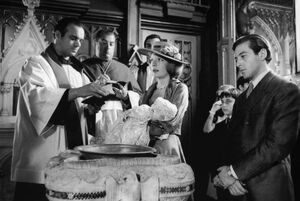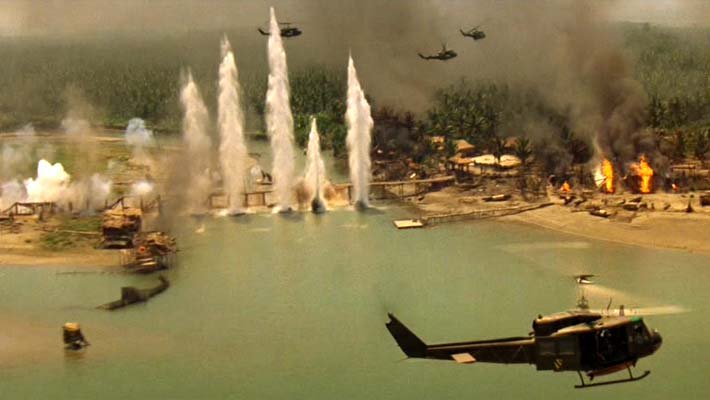
Wednesday, December 2, 2009
Citizen Kane: Film review: Is Citizen Kane The Greatest Film Ever Made?

Tuesday, December 1, 2009
Film Noir Analytical Blog Entry

Night in the City: Film Reveiw

Sunday, November 22, 2009
A Touch of Evil: Film Review

The Maltese Falcon: Film Review

Saturday, November 21, 2009
Chinatown: Film Review

Monday, November 16, 2009
Daughters of the Dust and Monsoon Wedding V.S. Hollywood Convention
Tuesday, November 10, 2009
Monsoon Wedding: Film Review

Wednesday, November 4, 2009
Daughters of the Dust: Film Review

Tuesday, November 3, 2009
Casablanca

A Closer Look at Bonnie and Clyde

The 1967 film Bonnie and Clyde is considered a "landmark film" as it broke many traditional restrictions. This film completely changed film making mainly because of its unique style of editing. There were times when this film was very slow - paced and casual (as in dialogue scenes). The shots in these scenes lasted longer. However, there were times when this film was fast - paced (chase scenes). The shots in these scenes quickly alternated from Barrow's gang to the police, or whoever was chasing them. There were also times in this film in which the editing seemed very “choppy” (Bonnie and Clyde death scene). I believe “choppy” editing occurs in this film because it is a timing thing. It stresses the importance of the pace of the film. It also adds suspense to the film. However, this combination of editing styles added to the overall quality of the film and added suspense to the film.
There were a few scenes in this film that had choppy editing. However, there were two scenes that really stuck out to me. I thought these two scenes had a lot of choppy editing. The first scene that stuck out to me was the chase scene that eventually led Clyde and his gang into Oklahoma. http://www.youtube.com/watch?v=iVsovDXPBb8 In this scene, Clyde and his gang have just pulled off their first bank robbery together. The camera alternates between quick 2 – 3 second shots of the car getting away and 2 – 3 second shots of Clyde and his gang in the car. This is to basically add suspense to the scene.
Another scene that I thought had choppy editing was the Bonnie and Clyde death scene at the end of the film. http://www.youtube.com/watch?v=Q5GDcs8i2ng&feature=related In this scene, Clyde and Bonnie discover C.W.’s father on the side of the road and they decide to pull over. They soon find out that they have been set up. C.W.’s father looks at the bushes when birds flew out and he hits the deck. Clyde realizes that he and Bonnie have been set up. The camera quickly alternates 1 second close – up shots of Bonnie and Clyde before they both end up getting shot to death. Again, this is to add suspense and uncertainty to the scene. Bonnie and Clyde have been caught and the choppy editing leaves the audience guessing about what’s going to happen to Bonnie and Clyde.
There were times in this film when the editing seemed choppy. However, the choppy editing occurred to add suspense to the film and to emphasize the overall pace of the film.
Wednesday, October 21, 2009
Bonnie and Clyde: Film Review

Sunday, October 18, 2009
A Closer Look at Run, Lola, Run

Saturday, October 17, 2009
Run, Lola, Run: Film Review














 The 1998 German film Run, Lola, Run was written and directed by Tom Tykwer. This film narrates a girl named Lola (played by Franka Potente) and her boyfriend Manni (played by Mortiz Bleibtreu). This film begins with Lola receiving a phone call from Manni, who is frantically telling her that he needs to obtain 100,000 Deutsche mark in twenty minutes or else his life would be in jeopardy. He also tells her that he is considering to rob a nearby drug store, so that he can obtain the money. However, Lola tells Manni to stay right where he is and she will figure out a way to obtain the money and then meet him where he is.
The 1998 German film Run, Lola, Run was written and directed by Tom Tykwer. This film narrates a girl named Lola (played by Franka Potente) and her boyfriend Manni (played by Mortiz Bleibtreu). This film begins with Lola receiving a phone call from Manni, who is frantically telling her that he needs to obtain 100,000 Deutsche mark in twenty minutes or else his life would be in jeopardy. He also tells her that he is considering to rob a nearby drug store, so that he can obtain the money. However, Lola tells Manni to stay right where he is and she will figure out a way to obtain the money and then meet him where he is.The interesting thing about this film is that from the moment that Lola hangs up the phone, the is divided into three different scenarios. In each scenario, Lola decides to go to her father for the money. She is always running through the streets of Berlin so that she can get to her father's bank. However, in each scenario something different happens. For example, in the first scenario, Lola's father refuses to give her the money and basically kicks her out of his bank. He tells her that he is not her actual father and that he is intending to leave Lola and her mother for another woman. Lola walks out of the bank, and even though she does not have the money, she runs to where Manni said he was. To her shock and surprise, when she gets to where Manni said he would be, Manni is already robbing the drug store that he said he was considering to rob. Lola decides then, to help Manni rob the drug store. They both leave the drug store together. However, they run into the police. The first scenario ends with a police officer accidentally shooting Lola. Her final words to Manni are," I don't want to leave.... Stop." The screen then fades to red.
If you want to know more about this movie, then I suggest that you go see it. Personally, I liked this movie and I thought it was put together very well. I thought that it was action - packed and suspenseful. I also thought that this film not only told a suspenseful story, but also a romantic story. Throughout this film, the viewer discovers more and more how much Lola and Manni really love each other. Overall, I liked this film and I would recommend it to people who want to see a good thriller.
Friday, October 16, 2009
A Closer Look at Do The Right Thing: Analytical Review

Wednesday, October 7, 2009
Do The Right Thing Film Review

Wednesday, September 30, 2009
Taking a Closer Look at The Godfather


Thursday, September 24, 2009
Wednesday, September 23, 2009
A Closer Look at Apocalypse Now
 All throughout Apocalypse Now, Francis Ford Coppola uses excellent cinematography techniques, such as camera proximity, camera angles, and color. As Captain Willard is being asked to assassinate Colonel Kurtz "...with extreme prejudice...", Coppola uses great camera proximity as shoots the faces of Willard, General Corman, and Colonel Lucas at a reasonable close - up distance. I noticed that Coppola zooms in on objects as well. For example, when General Corman and Colonel Lucas play back voice of Colonel Kurtz, Coppola zooms in on the "tape recorder." The camera proximity technique adds to the intensity of the film as the audience can read the emotion on the actors faces.
All throughout Apocalypse Now, Francis Ford Coppola uses excellent cinematography techniques, such as camera proximity, camera angles, and color. As Captain Willard is being asked to assassinate Colonel Kurtz "...with extreme prejudice...", Coppola uses great camera proximity as shoots the faces of Willard, General Corman, and Colonel Lucas at a reasonable close - up distance. I noticed that Coppola zooms in on objects as well. For example, when General Corman and Colonel Lucas play back voice of Colonel Kurtz, Coppola zooms in on the "tape recorder." The camera proximity technique adds to the intensity of the film as the audience can read the emotion on the actors faces. Apocalypse Now
 The 1979 war film Apocalypse Now, takes place during the Vietnam War. Captain Benjamin Willard (played by Martin Sheen) is lifted from his drunken and depressed state and is approached by General Corman (played by G.D. Spradlin) and Colonel Lucas (played by the one and only Harrison Ford) with an assignment: travel up the Nung River into the Cambodian jungle to kill one of the U.S. army's own men, Colonel Walter Kurtz (played by Marlon Brando). Willard is informed that Kurtz has gone insane and Willard must end the Colonel's command.
The 1979 war film Apocalypse Now, takes place during the Vietnam War. Captain Benjamin Willard (played by Martin Sheen) is lifted from his drunken and depressed state and is approached by General Corman (played by G.D. Spradlin) and Colonel Lucas (played by the one and only Harrison Ford) with an assignment: travel up the Nung River into the Cambodian jungle to kill one of the U.S. army's own men, Colonel Walter Kurtz (played by Marlon Brando). Willard is informed that Kurtz has gone insane and Willard must end the Colonel's command. 